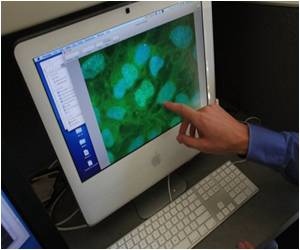Generally cancer cells have something that every prisoner longs for, that is a master key that allows them to escape.

Unless it can enter a blood or lymphatic vessel, a cancer cell is imprisoned in the tissue where it arises. The growth factor VEGF is the tumor cell's master key. It loosens connections between endothelial cells that form the lining of blood vessel walls, enabling the cancer cell to squeeze through, plunge into the bloodstream, and then spread to other tissues in a process called metastasis.
VEGF fosters this escape by triggering the phosphorylation of a protein called VEC, which helps fasten endothelial cells together. This alteration causes the complexes that contain VEC to fall apart, opening gaps between endothelial cells. Researchers haven't uncovered all of the steps leading to VEC phosphorylation, but one protein that might be involved is focal adhesion kinase (FAK), which accumulates at cell-to-cell junctions in the presence of VEGF.
To pinpoint the protein's function, researchers from the UC San Diego Moores Cancer Center gave a FAK inhibitor to a group of mice with fast-spreading breast cancer and a group with ovarian tumors. Previous work had shown that the inhibitor thwarts tumor growth, and in both groups of mice the researchers found that it prevented phosphorylation of a specific amino acid—tyrosine 658—in VEC from tumor-associated blood vessels. The researchers then injected VEGF into control mice and into mice with an inactive variant of FAK in their endothelial cells. VEGF spurred phosphorylation of VEC's tyrosine 658 in the control rodents but not in the animals expressing inactive FAK, providing further evidence that FAK controls this event.
The researchers next tested whether FAK helps unlock endothelial layers. They determined the effect of VEGF-releasing tumor cells on endothelial cell cultures. Tumor cells first adhered to the endothelial layer and then slipped through. When the endothelial cells produced an inactive form of FAK, the tumor cells were still able to stick to the layer but couldn't cross it. When the endothelial cell layers carried VEC mutants that could not be phosphorylated at tyrosine 658, tumor cells also had a hard time slipping through.
The researchers also measured FAK's effect on metastasis in mice that had been injected with invasive tumor cells. Compared with control animals, mice that expressed inactive FAK in their endothelial cells showed fewer tumor cells in their lungs. Blocking endothelial FAK curbed metastasis without altering tumor growth, the team found.
Advertisement
Source-Eurekalert












